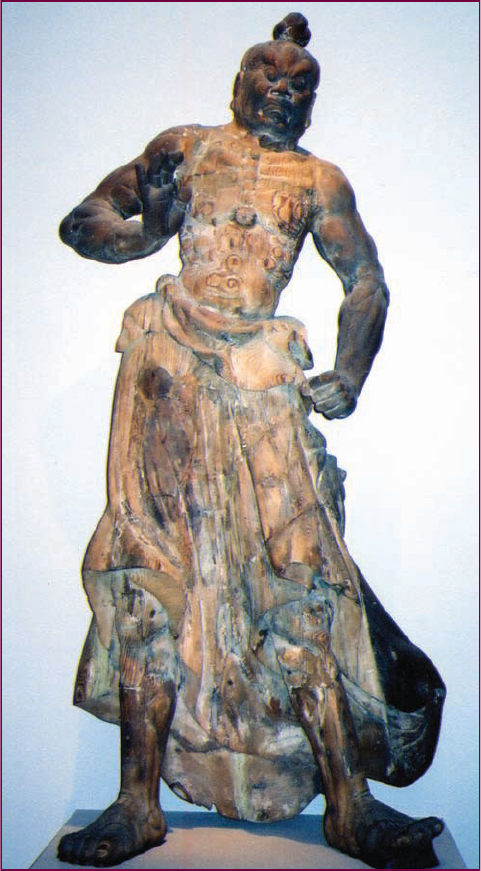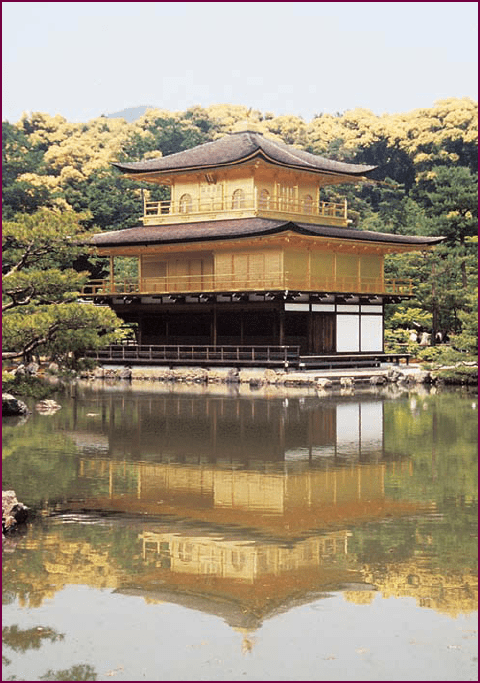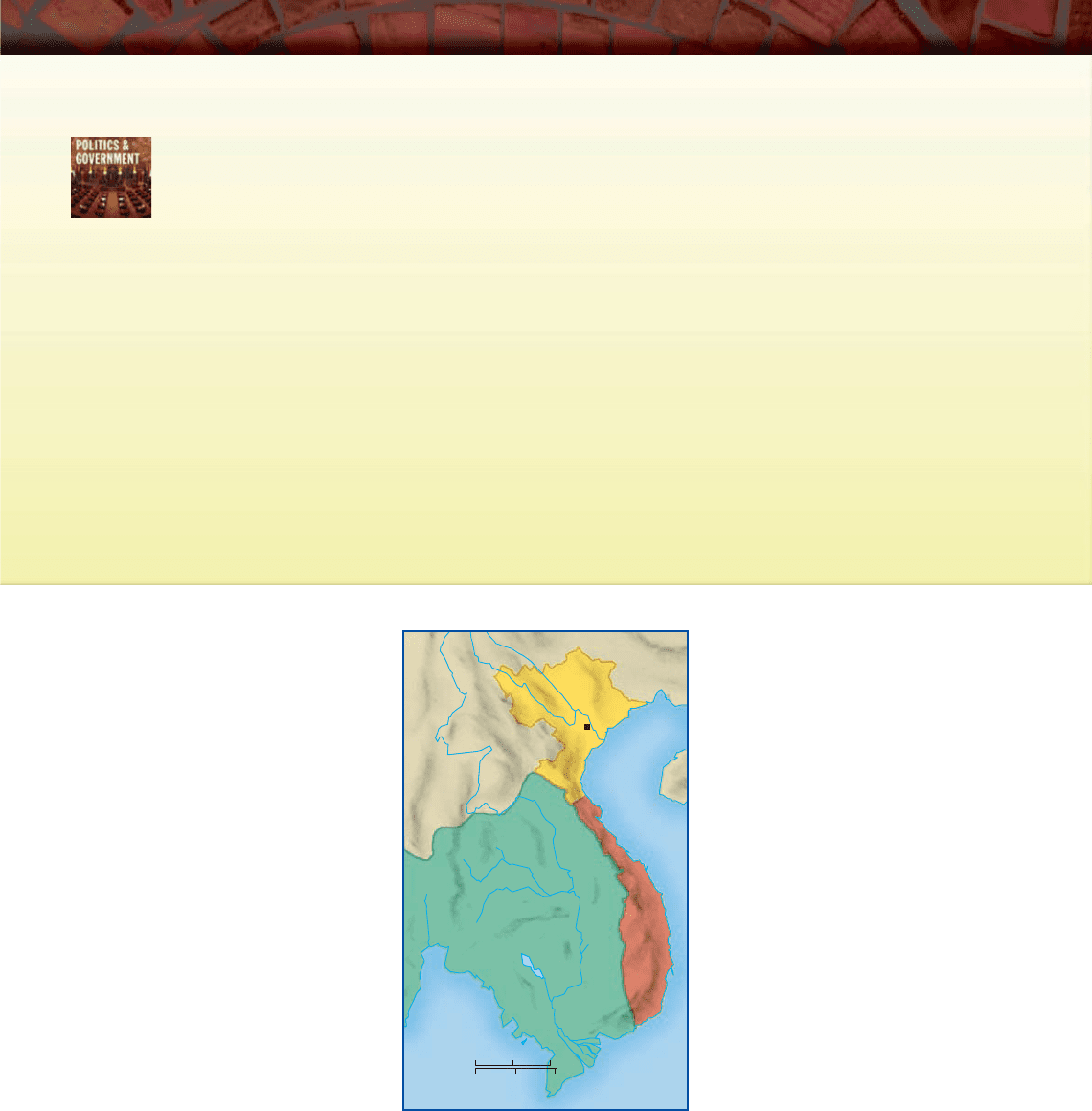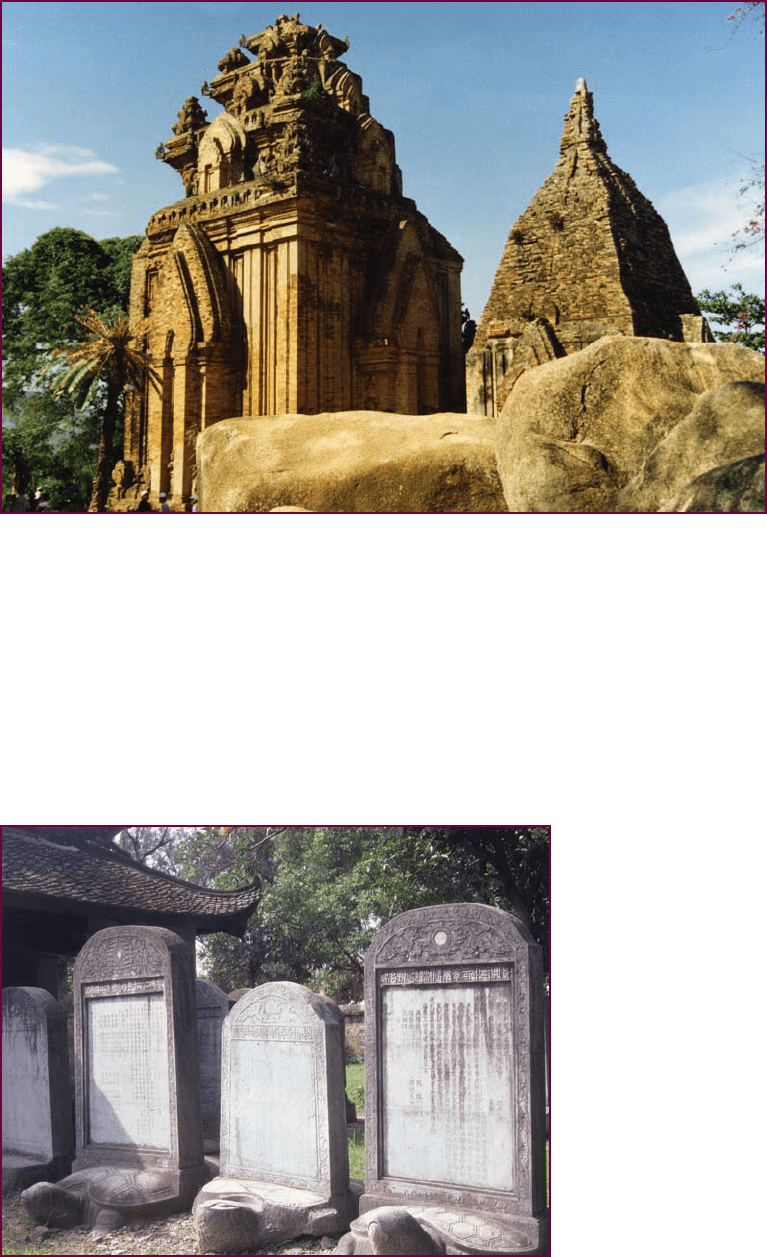Duiker W.J., Spielvogel J.J. The Essential World History. Volume 1: To 1800
Подождите немного. Документ загружается.


Missions sent to China and Korea during the seventh and
eighth centuries returned with examples of Tang litera-
ture, sculpture, and painting, all of which influenced the
Japanese.
Literature Borrowing from Chinese models was some-
what complicated, however, since the early Japanese had
no writing system for recording their own spoken lan-
guage and initially adopted the Chinese written language
for writing. But resourceful Japanese soon began to adapt
the Chinese written characters so that they could be used
for recording the Japanese language. In some cases, Chi-
nese characters were given Japanese pronunciations. But
Chinese characters ordinarily could not be used to record
Japanese words, which normally contain more than one
syllable. Sometimes the Japanese simply used Chinese
characters as phonetic symbols that were combined to
form Japanese words. Later they simplified the characters
into phonetic symbols that we r e used alongside Chinese
characters. This hybrid system continues to be used today.
At first, most educated Japanese preferred to write
in Chinese, and a court literature---consisting of essays,
poetry, and official histories---appeared in the classical
Chinese language. But spoken Japanese never totally
disappeared among the educated classes and eventually
became the instrument of a unique literature. With the
lessening of Chinese cultural influence in the tenth cen-
tury, Japanese verse resurfaced. Between the tenth and
fifteenth centuries, twenty imperial anthologies of poetry
were compiled. Initially, they were written primarily by
courtiers, but with the fall of the Heian court and the rise
of the warrior and merchant classes, all literate segments
of society began to produce poetry.
Japanese poetry is unique. It expresses its themes in a
simple form, a characteristic stemming from traditional
Japanese aesthetics, Zen religion, and the language itself.
The aim of the Japanese poet was to create a mood,
perhaps the melancholic effect of gently falling cherry
blossoms or leaves. With a few specific references, the
poet suggested a whole world, just as Zen Buddhism
sought enlightenment from a sudden perception. Poets
often alluded to earlier poems by repeating their images
with small changes, a technique that was viewed not as
plagiarism but as an elaboration on the meaning of the
earlier poem.
By the fourteenth century, the technique of ‘‘linked
verse’’ had become the most popular form of Japanese
poetry. Known as haiku, it is composed of seventeen syl-
lables divided into lines of five, seven, and five syllables. The
poems usually focused on images from nature and called
attention to the mutability of life. Often the poetry was
written by several individuals alternately composing verses
and linking them together into long sequences of hundreds
and ev en thousands of lines (see the box abo v e).
Poetry served a unique function at the Heian
court, where it was the initial means of communication
ASAMPLE OF LINKED VERSE
One of the distinctive features of medieval
Japanese literature was the technique of ‘‘linked
verse.’’ In a manner similar to haiku poetry today,
such poems, known as renga, were written by
groups of individuals who would join together to compose the
poem, verse by verse. The following example, by three famous
poets named Sogi, Shohaku, and Socho, is one of the most
famous of the period.
The Three Poets at Minase
Snow clinging to slope, Sogi
On mist-enshrouded mountains
At eveningtime.
In the distance flows Shohaku
Through plum-scented villages.
Willows cluster Socho
In the river breeze
As spring appears.
The sound of a boat being poled Sogi
In the clearness at dawn
Still the moon lingers Shohaku
As fog o’er-spreads
The night.
A frost-covered meadow; Socho
Autumn has drawn to a close.
Against the wishes Sogi
Of droning insects
The grasses wither.
Q
How do these Japanese poems differ from the poems
written in China during the Tang dynasty that were presented
in Chapter 10?
274 CHAPTER 11 THE EAST ASIAN RIMLANDS: EARLY JAPAN, KOREA, AND VIETNAM

between lovers. By custom, aristocratic women were
isolated from all contact w ith men outside their imme-
diate family and spent their days hidden behind screens.
Some amused themselves by writing poetry. When
courtship began, poetic exchanges were the only means a
woman had to attract her prospective lover, who would
be enticed solely by her poetic art.
During the Heian period, male courtiers wrote in
Chinese, believing that Chinese civilization was superior
and worthy of emulation. Like the Chinese, they viewed
prose fiction as ‘‘vulgar gossip.’’ Nevertheless, from the
ninth century to the twelfth, Japanese women were prolific
writer s of prose fiction in Japanese. Excl uded from school,
they learned to read and write at home and wrote diaries
and stories to pass the time. Some of the most talented
women were invited to court as authors in residence.
In the increasingly pessimistic world of the warring
states of the Kamakura period (1185--1333), Japanese
novels typically focused on a solitary figure who is aloof
from the refinements of the court and faces battle and
possibly death. Another genre, that of the heroic war tale,
came out of the new warrior class. These works described
the military exploits of warriors, coupled with an over-
whelming sense of sadness and loneliness.
The famous classical Japanese drama known as No
also originated during this period. No developed out of a
variety of entertainment forms, such as dancing and jug-
gling, that were part of the native tradition or had been
imported from China and other regions of Asia. The plots
were normally based on stories from Japanese history or
legend. Eventually , No evolved into a highly stylized drama
in which the performers wore masks and danced to the
accompaniment of instrumental music. Like much of
Japanese culture, No was restrained, graceful, and refined.
Art and Architecture In art and architecture, as in lit-
erature, the Japanese pursued their interest in beauty,
simplicity, and nature. To some degree, Japanese artists
and architects were influenced by Chinese forms. As they
became familiar with Chinese architecture, Japanese rul-
ers and aristocrats tried to emulate the splendor of Tang
civilization and began constructing their palaces and
temples in Chinese style.
During the Heian period (794--1185), the search
for beauty was reflected in various art forms, such as
narrative hand scrolls, screens, sliding door panels, fans,
and lacquer decoration. As in literature, nature themes
dominated, such as seashore scenes, a spring rain, moon
and mist, or flowering wisteria and cherry blossoms. All
were intended to evoke an emotional response on the part
of the viewer. Japanese painting suggested the frail beauty
of nature by presenting it on a smaller scale. The majestic
mountain in a Chinese painting became a more intimate
Japanese landscape with rolling hills and a rice field. Faces
were rarely shown, and human drama was indicated by a
woman lying prostrate or hiding her face in her sleeve.
Tension was shown by two people talking at a great dis-
tance or with their backs to one another.
During the Kamakura period (1185--1333), the hand
scroll with its physical realism and action-packed paint-
ings of the new warrior class achieved great popularity.
Reflecting these chaotic times, the art of portraiture
Guardian K ings. Larger than life and intimidating in its presence, this
thirteenth-century wooden statue departs from the refined atmosphere of
the Heian court and pulsates with the masculine energy of the Kamakura
period. Placed strategically at the entrance to Buddhist shrines, guardian
kings such as this one protected the temple and the faithful. In contrast to
the refined atmosphere of the Fujiwara court, the Kamakura era was a
warrior’s world.
c
William J. Duiker
JAPAN:LAND OF THE RISING SUN 275

flourished, and a scroll would include a full gallery of
warriors and holy men in starkly realistic detail, including
such unflattering features as stubble, worry lines on a
forehead, and crooked teeth. Japanese sculptors also
produced naturalistic wooden statues of generals, nobles,
and saints. By far the most distinctive, however, were the
fierce heavenly ‘‘guardian kings,’’ who still intimidate the
viewer today.
Zen Bu ddhism, an import from China in the t hir-
teenth century, also influenced Japanese aesthetics. With
its emphasis on immediate enlightenment without re-
course to intellectual analysis and elaborate ritual, Zen
reinforced the Japanese predilection for sim plicity and
self-discipline. D uring this era, Zen philosophy found
expression in the Japanese garden, the tea ceremony, the
art of flower arranging, pottery and ceramics, an d
miniature plant display (the famous bonsai, literally
‘‘pot scenery’’).
Landscapes served as an important means of ex-
pression in both Japanese art and architecture. Japanese
gardens were initially modeled on Chinese examples.
Early court texts during the Heian period emphasized the
importance of including a stream or pond when creating
a garden. The landscape surrounding the fourteenth-
century Golden Pavilion in Kyoto displays a harmony of
garden, water, and architecture that makes it one of the
treasures of the world. Because of the shortage of water in
the city, later gardens concentrated on rock compositions,
using white pebbles to represent water.
Like the Japanese garden, the tea ceremony repre-
sents the fusion of Zen and aesthetics. Developed in the
fifteenth century, it was practiced in a simple room
devoid of external ornament except for a tatami floor,
sliding doors, and an alcove with a writing desk and
asymmet rical shelves. The parti cipants could therefore
focus completely on the activity of pouring and drink-
ing tea. ‘‘Tea and Zen have the same flavor,’’ goes the
Japanese saying. Considered the u ltimate symbol of
spiritual deliverance, the tea ceremony had great aes -
thetic value and moral significance in traditional times
just as it does today.
Japan and the Chinese Model
Few societies in Asia have historically been as isolated as
Japan. Cut off from the mainland by 120 miles of fre-
quently turbulent ocean, the Japanese had only minimal
contact w ith the outside world during most of their early
development.
Whether this isolation was ultimately beneficial to
Japanese society cannot be determined. On the one hand,
the lack of knowledge of developments taking place
elsewhere probably delayed the process of change in
Japan. On the other hand, the Japanese were spared the
destructive invasions that afflicted other ancient civi-
lizations. Certainly, once the Japanese became acquainted
with Chinese culture at the height of the Tang era, they
were quick to take advantage of the opportunity. In the
space of a few decades, the young state adopted many
aspects of Chinese society and culture and thereby in-
troduced major changes into Japanese life.
Nevertheless, Japanese political institutions failed to
follow all aspects of the Chinese pattern. Despite Prince
Shotoku’s effort to make effective use of the imperial
traditions of Tang China, the decentralizing forces inside
Japanese society remained dominant throughout the pe-
riod under discussion in this chapter. Adoption of the
Confucian civil service examination did not lead to a
The Gold en Pav ilion i n Ky oto. The landscape surrounding the
Golden Pavilion displays a harmony of garden, water, and architecture that
makes it one of the treasures of the world. Constructed in the fourteenth
century as a retreat where the shoguns could withdraw from their
administrative chores, the pavilion is named for the gold foil that covered
its exterior. Completely destroyed by an arsonist in 1950 as a protest
against the commercialism of modern Buddhism, it was rebuilt and
reopened in 1987. The use of water as a backdrop is especially noteworthy
in Chinese and Japanese landscapes, as well as in the Middle East.
c
William J. Duiker
276 CHAPTER 11 THE EAST ASIAN RIMLANDS: EARLY JAPAN, KOREA, AND VIETNAM

breakdown of Japanese social divisions; instead the ex-
amination was administered in a manner that preserved
and strengthened them. Although Buddhist and Daoist
doctrines made a significant contribution to Japanese
religious practices, Shinto beliefs continued to play a
major role in shaping the Japanese worldview.
Why Japan did not follow the Chinese road to cen-
tralized authority has been the subject of some debate
among historians. Some argue that the answer lies in
differing cultural traditions, while others suggest that
Chinese institutions and values were introduced too
rapidly to be assimilated effectively by Japanese society.
One factor may have been the absence of a foreign threat
(except for the Mongols) in Japan. A recent view holds
that diseases (such as smallpox and measles) imported
inadvertently from China led to a marked decline in the
population of the islands, reducing the food output and
preventing the population from coalescing in more
compact urban centers.
In any event, Japan was not the only society in Asia to
assimilate ideas from abroad while at the same time pre-
serving customs and institutions inherited from the past.
Across the Sea of Japan to the west and several thousand
miles to the south, other Asian peoples were embark ed on
a similar journey. We now turn to their experience.
Korea: Bridge to the East
Q
Focus Question: What were the main characte ristics of
economic and social life in early Korea?
Few of the societies on the periphery of China have been
as directly influenced by the Chinese model as Korea.
Nevertheless, the relationship between China and Korea
has often been characterized by tension and conflict, and
Koreans have often resented what they perceive to be
Chinese chauvinism and arrogance.
A graphic example of this attitude has occurred in
recent years as officials and historians in both countries
have vociferously disputed differing interpretations of the
early history of the Korean people. Slightly larger than the
state of Minnesota, the Korean peninsula was probably
first settled by Altaic-speaking fishing and hunting peo-
ples from neighboring Manchuria during the Neolithic
Age. Because the area is relatively mountainous (only
about one-fifth of the peninsula is adaptable to cultiva-
tion), farming was apparently not practiced until about
2000
B.C.E. At that time, the peoples living in the area
began to form organized communities.
This is also the time at which scholarly disagreement
arises. In 2004, official Chinese sources claimed that the
first organized kingdom in the area, known as Koguryo
(37
B.C.E.--668 C.E.), occupied a wide swath of Manchuria
as well as the northern section of the Korean peninsula
and was thus an integral part of Chinese history. Korean
scholars, basing their contentions on both legend and
scattered historical evidence, countered that the first
kingdom established on the peninsula, known as Gojo-
seon, was created by the Korean ruler Dangun in or about
2333
B.C.E. and was ethnically Korean. It was at that time,
these scholars maintain, that the Bronze Age got under
way in northeastern Asia.
Although the facts relating to this issue continue
to be in dispute, most scholars today do agree that in
109
B.C.E., the northern part of the peninsula came under
direct Chinese rule. During the next several generations,
the area was ruled by the Han dynasty, which divided the
territory into provinces and introduced Chinese in-
stitutions. With the decline of the Han in the third cen-
tury
C.E., power gradually shifted to local tribal leaders,
who drove out the Chinese administrators but continued
to absorb Chinese cultural influence. Eventually, three
separate kingdoms emerged on the peninsula: Koguryo in
the north, Paekche in the southwest, and Silla in the
southeast. The Japanese, who had recently established
their own state on the Yamato plain, may have main-
tained a small colony on the southern coast.
The Three Kingdoms
From the fourth to the seventh centuries, the three
kingdoms were bitter rivals for influence and territor y
on the peninsula. At the same time, all began to absorb
Chinese political and cultural institutions. Chinese in-
fluence was most notable in Koguryo, where Buddhism
was introduced in the late fourth century
C.E.andthe
first Confucian academy on the peninsula was estab-
lished in the capital at Pyongyang . All three kingdoms
also a ppear to have accepted a tributary relationship
with one or another
of the squabbling
states that emerged
in China after the
fall of the Han. The
kingdom of Silla, less
exposed than its two
rivals to Chinese in-
fluence, was at first
the weakest of the
three, but eventually
its greater internal
cohesion---perhaps a
consequence o f the
tenacity of its tribal
traditions---enabled it
Kyongju
Pyongyang
PAEKCHE
SILLA
KOGURYO
Y
a
l
u
R
.
Yellow
Sea
Sea of Japan
(East Sea)
200 Miles0
300 Kilometers0
Korea’s Th ree Kingdo ms
KOREA:BRIDGE TO THE EAST 277

to become the dominant power on the peninsula. Then
the rulers of Silla forced the Chinese to withdraw from all
but the area adjacent to the Yalu River. To pacify the
haughty Chinese, Silla accepted tributary status under the
Tang dynasty. The remaining Japanese colonies in the
south were eliminated.
With the country unified for the first time, the rulers
of Silla attempted to use Chinese political institutions and
ideology to forge a centralized state. Buddhism, now
rising in popularity, became the state religion, and Korean
monks followed the paths of their Japanese counterparts
on journeys to the Middle Kingdom. Chinese architecture
and art became dominant in the capital at Kyongju and
other urban centers, and the written Chinese language
became the official means of communication at court.
But powerful aristocratic families, long dominant in the
southeastern part of the peninsula, were still influential at
court. They were able to prevent the adoption of the Tang
civil service examination system and resisted the distri-
bution of manorial lands to the poor. The failure to adopt
the Chinese model was fatal. Squabbling among noble
families steadily increased, and after the assassination of
the king of Silla in 780, civil war erupted.
The Rise of the Koryo Dynasty
In the early tenth century, a new dynasty called Koryo (the
root of the modern word for Korea) arose in the north.
The new kingdom adopted Chinese political institutions
in an effort to strengthen its power and unify its territory.
The civil service examination system was introduced in
958, but as in Japan, the bureaucracy continued to be
dominated by influential aristocratic families.
The Koryo dynasty remained in power for four
hundred years, protected from invasion by the absence of
a strong dynasty in neighboring China. Under the Koryo,
industry and commerce slowly began to develop, but as in
China, agriculture was the prime source of wealth. In
theory, all land was the property of the king, but in ac-
tuality, noble families controlled their holdings. The lands
were worked by peasants who were subject to burdens
similar to those of European serfs. At the bottom of
The So kkuram Buddha. As Buddhism spread from India to other
parts of Asia, so did the representation of the Buddha in human form.
From the first century
C.E., statues of the Buddha began to absorb various
cultural influences. Some early sculptures, marked by flowing draperies,
reflected the Greek culture introduced to India during the era of Alexander
the Great. Others were reminiscent of traditional male earth spirits, with
broad shoulders and staring eyes. Under the Guptas, artists emphasized the
Indian ideal of spiritual and bodily perfection.
As the faith spread along the Silk Road, representations of the Buddha
began to reflect cultural influence from Persia and China, and eventually
from Korea and Japan. Shown here is the eighth-century Sokkuram
Buddha, created in the kingdom of Silla. Unable to construct a structure
similar to the cave temples in China and India because of the hardness of
the rock in the nearby hills, Korean builders erected a small domed cave
out of granite blocks and a wooden veranda (see the inset). Today,
pilgrims still climb the steep hill to pay homage to this powerful and
serene Buddha, one of the finest in Asia.
c
Bulguksa Temple, South Korea/The Bridgeman Art Library
c
William J. Duiker
278 CHAPTER 11 THE EAST ASIAN RIMLANDS: EARLY JAPAN, KOREA, AND VIETNAM

society was a class of ‘‘base people’’ (chonmin), composed
of slaves, artisans, and other specialized workers.
From a cultural point of view, the Koryo era was one
of high achievement. Buddhist monasteries, run by sects
introduced from China, including Pure Land and Zen
(Chan), controlled vast territories, while their monks
served as royal advisers at court. At first, Buddhist themes
dominated in Korean art and sculpture, and the entire
Tripitaka (the ‘‘three baskets’’ of the Buddhist canon) was
printed using wooden blocks. Eventually, however, with
the appearance of landscape painting and porcelain,
Confucian themes began to predominate.
Under the Mongols
Like its predecessor in Silla, the kingdom of Koryo was
unable to overcome the power of the nobility and the
absence of a reliable tax base. In the thirteenth century,
the Mongols seized the northern part of the country and
assimilated it into the Yuan Empire. The weakened
kingdom of Koryo became a tributary of the Great Khan
in Khanbaliq (see Chapter 10).
The era of Mongol rule was one of profound suf-
fering for the Korean people, especially the thousands of
peasants and artisans who were compelled to perform
forced labor to help build the ships in preparation for
Khubilai Khan’s invasion of Japan. On the positive side,
the Mongols introduced many new ideas and technology
from China and farther afield. The Koryo dynasty had
managed to survive, but only by accepting Mongol au-
thor ity, and when the power of the Mongols declined,
the kingdom declined with it. With the rise to power
of the Min g in China, Koryo collapse d, and power was
seized by the military commander Yi Song -gye, who
declared the founding of the new Yi dynasty in 1392.
Once again, the Korean people were in charge of th eir
own destiny.
Vietnam: The Smaller Dragon
Q
Focus Questions: What were the main developments
in Vietnamese history before 1500? Why were the
Vietnamese able to restore their national independence
after a millennium of Chinese rule?
While the Korean people were attempting to establish
their own identity in the shadow of the powerful Chinese
empire, the peoples of Vietnam, on China’s southern
frontier, were seeking to do the same. The Vietnamese
(known as the Yueh in Chinese, from the peoples of that
name inhabiting the southeastern coast of mainland
China) began to practice irrigated agriculture in the
flooded regions of the Red River delta at an early date
and entered the Bronze Age sometime during the second
millennium
B.C.E. By about 200 B.C.E., a young state
had begun to form in the area but immediately en-
countered the expanding power of the Qin Empire (see
Chapter 3). The Vietnamese were not easy to subdue,
however, and the collapse of the Qin dynasty temporarily
enabled them to preserve their independence (see the box
on p. 280). Nevertheless, a century later, they were ab-
sorbed into the Han Empire.
At first, t he Han were content to rule the delta as an
autonomous regi on under the administration of the
local landed aristocracy. But Chinese taxes were op-
pressive, and in 39
C.E., a revolt led by the Trung sisters
(widows of local nobles who had been executed by the
Chinese) briefly brought Han rule to an end. The Chi-
nese soon suppressed the rebellion, however, and began
to rule the area directly through officials dispatched
from China. The first Chinese officials to serve in the
region became exasperated at the u ncultured ways of
the locals, who wandered around ‘‘naked without
shame .’’
7
In ti me, however, these foreign officials began
to in termarry with the local nobility and form a Sino-
Vietnamese ruling class who, though trained in Chinese
culture, began to iden tify with the cause of Vietnamese
autonomy.
For nearly a thousand years, the Vietnamese were
exposed to the art, architecture, literature, philosophy,
and written language of China as the Chinese attempted
to integrate the area culturally as well as politically and
administratively into their empire. It was a classic case of
the Chinese effort to introduce advanced Confucian civ-
ilization to the ‘‘backward peoples’’ along the perimeter.
To all intents and purposes, the Red River delta, then
known to the Chinese as the ‘‘pacified South’’ (Annam),
became a part of China.
The Rise of Great Viet
Despite the Chinese efforts to assimilate Vietnam, the
Vietnamese sense of ethnic and cultural identity proved
inextinguishable, and in the tenth century, the Vietnam-
ese took advantage of the collapse of the Tang dynasty in
China to overthrow Chinese rule.
The new Vietnamese state, which called itself Dai
Viet (Great Viet), became a dynamic new force on the
Southeast Asian mainland. As the population of the Red
River delta expanded, Dai Viet soon came into conflict
with Champa, its neighbor to the south. Located along
the central coast of modern Vietnam, Champa was a
trading society based on Indian cultural traditions. Over
the next several centuries, the two states fought on nu-
merous occasions. By the end of the fifteenth century,
VIETNAM:THE SMALLER DRAGON 279

Dai Viet had conquered Champa. The
Vietnamese then resumed their march
southward, establishing agricultural
settlements in the newly conquered
territory. By the seventeenth century,
the Vietnamese had reached the Gulf
of Siam.
The Vietnamese faced an even
more serious challenge from the
north. The Song dynasty in China,
beset w ith its own problems on the
northern frontier, eventually ac-
cepted the Dai Viet ruler’s offer of
tribute status, but later dynasties
attempted to reintegrate the Red
River delta into the Chinese Empire.
The first effort was made in the late
thirteenth centur y by the Mongols,
who attempted on two occasions to
conquer the Vietnamese. After a se-
ries of bloody battles, during which
the Vietnamese displayed an im-
pressive capacity for guerrilla war-
fare, t he invaders were driven out. A little over a
century later, the Ming dynasty tried again, and for
twenty years Vietnam was once more under Chinese
rule. In 1428, the Vietnamese evicted the Chinese again,
but the experience had contributed to the strong sense
of Vietnamese identity.
The Chinese Legacy Despite their
stubborn resistanc e to Chinese rule, af-
ter the restoration of independence in
the tenth century , Vietnamese rulers
quickly discovered the conv enienc e of
the Confucian model in administering a
river valley society and therefore at-
tempted to follow Chinese practice in
forming their own state. The ruler
styled himself an emperor lik e his
counterpart to the north (although he
prudently termed himself a king in his
direct dealings with the Chinese court),
adopted Chinese court rituals, claimed
the mandate of Heaven, and arrogated
to himself the same authority and
privileges in his dealings with his sub-
jects. But unlik e a Chinese emperor,
who had no particular symbolic role as
defender of the Chinese people or
Chinese culture, a Vietnamese monarch
was viewed, above all, as the symbol and
defender of Vietnamese independenc e.
Like their Chinese counterparts, Vietnamese rulers
fought to preserve their authority from the challenges of
powerful aristocratic families and turned to the Chinese
bureaucratic model, including civil service examinations,
as a means of doing so. Under the pressure of strong
monarchs, the concept of merit eventually took hold, and
THE FIRST VIETNAM WAR
In the third century B.C.E., the armies of the
Chinese state of Qin (Ch’in) invaded the Red River
delta to launch an attack on the small Vietnamese
state located there. As this passage from a Han
dynasty philosophical text shows, the Vietnamese were not
easy to conquer, and the new state soon declared its indepen-
dence from the Qin. It was a lesson that was too often forgot-
ten by would-be conquerors in later centuries.
Masters of Huai Nan
Ch’in Shih Huang Ti [the first emperor of Qin] was interested in
the rhinoceros horn, the elephant tusks, the kingfisher plumes, and
the pearls of the land of Yueh [Viet]; he therefore sent Commis-
sioner T’u Sui at the head of five hundred thousand men divided
into five armies. ... For three years the sword and the crossbow
were in constant readiness. Superintendent Lu was sent; there was
no means of assuring the transport of supplies so he employed sol-
diers to dig a canal for sending grain, thereby making it possible
to wage war on the people of Yueh. The lord of Western Ou,
I Hsu Sung, was killed; consequently, the Yueh people entered the
wilderness and lived there with the animals; none consented to be a
slave of Ch’in; choosing from among themselves men of valor, they
made them their leaders and attacked the Ch’in by night, inflicting
on them a great defeat and killing Commissioner T’u Sui; the dead
and wounded were many. After this, the emperor deported convicts
to hold the garrisons against the Yueh people.
The Yueh people fled into the depths of the mountains and
forests, and it was not possible to fight them. The soldiers were
kept in garrisons to watch over the abandoned t erritories. This
went on for a long time, and the soldiers grew weary. Then the
Yueh came out and attacked; the Ch’in soldiers suffered a great
defeat. Subsequently, convicts were sent to hold the garrisons
against the Yueh.
Q
How would the ancient Chinese military strategist Sun
Tzu, mentioned in Chapter 3, have advised the Qin military
commanders to carry out their operations? Would he have
approved of the tactics adopted by the Vietnamese?
DAI VIET
Thanglong
(Hanoi)
HAINAN
ISLAND
CHINA
ANGKOR
CHAMPA
Gulf of
Tonkin
Gulf
of
Siam
South
China
Sea
R
e
d
R
.
0 100 200 Miles
0 150 300 Kilometers
The Kin gdom o f Dai V iet, 1100
280 CHAPTER 11 THE EAST ASIAN RIMLANDS: EARLY JAPAN, KOREA, AND VIETNAM

the power of the landed aristocracy was weakened if not
entirely broken. The Vietnamese adopted much of the
Chinese administrative structure, including the six min-
istries, the censorate, and the various levels of provincial
and local administration.
Another aspect of the Chinese legacy was the spread
of Buddhist, Daoist, and Confucian ideas, which supple-
mented the Viets’ traditional belief in nature spirits.
Buddhist precepts became popular among the local pop-
ulation, who integrated the new faith into their existing
A Lost Civilization . Before the spread of Vietnamese settlers into the area early in the second millennium
C.E., much of the coast along the South China Sea was occupied by the kingdom of Champa. A trading people
who were directly engaged in the regional trade network between China and the Bay of Bengal, the Cham
received their initial political and cultural influence from India. This shrine-tower, located on a hill in the
modern city of Nha Trang, was constructed in the eleventh century and clearly displays the influence of Indian
architecture. Champa finally succumbed to a Vietnamese invasion in the fifteenth century.
The Temple of Literature, Hanoi. When the Vietnamese
regained their independence from China in the tenth century
C.E.,
they retained Chinese institutions that they deemed beneficial.
A prime example was the establishment of the Temple of
Literature, Vietnam’s first university, in 1076. Here sons of
mandarins (officials) were educated in the Confucian classics
in preparation for an official career. Beginning in the fifteenth
century, those receiving doctorates had stelae erected to identify
their achievements. More than eighty of these stelae were
erected on the school grounds over a space of three hundred
years.
c
William J. Duiker
c
William J. Duiker
VIETNAM:THE SMALLER DRAGON 281

belief system by founding Buddhist temples dedicated to
the local villag e deity in the hope of guaranteeing an
abundant harvest. Upper-class Vietnamese educated in the
Confucian classics tended to follow the more agnostic
Confucian doctrine, but some join ed Buddhist monas-
teries. Daoism also flourished at all levels of society and, as
in China, provided a structure for animistic beliefs and
practices that still predominated at the village level.
During the early period of independence, Vietnamese
culture also borrowed liberally from its larger neighbor.
Educated Vietnamese tried their hand at Chinese poetry,
wrote dynastic histories in the Chinese style, and followed
Chinese models in sculpture, architecture, and porcelain.
Many of the notable buildings of the medieval period,
such as the Temple of Literature and the famous One-
Pillar Pagoda in Hanoi, are classic examples of Chinese
architecture.
But there were signs that Vietnamese creativity would
eventually transcend the bounds of Chinese cultural
norms. Although most classical writing was undertaken
in literary Chinese, the only form of literary expression
deemed suitable by Confucian conservatives, an adapta-
tion of Chinese written characters, called chu nom
(‘‘southern characters’’), was devised to provide a written
system for spoken Vietnamese. In use by the early ninth
century, it eventually began to be used for the composi-
tion of essays and poetry in the Vietnamese language.
Such pioneering efforts would lead in later centuries to
the emergence of a vigorous national literature totally
independent of Chinese forms.
Society and Family Life
Vietnamese social institutions and customs were also
strongly influenced by those of China. As in China, the
introduction of a Confucian system and the adoption of
civil service examinations undermined the role of the old
landed aristocrats and led eventually to their replacement
by the scholar-gentry class. Also as in China, the exami-
nations were open to most males, regardless of family
background, which opened the door to a degree of social
mobility unknown in most of the states elsewhere in the
region. Candidates for the bureaucracy read many of the
same Confucian classics and absorbed the same ethical
principles as their counterparts in China. At the same
time, they were also exposed to the classic works of
Vietnamese history, which strengthened their sense that
Vietnam was a distinct culture similar to, but separate
from, that of China.
The vast majority of the Vietnamese people, however,
were peasants. Most were small landholders or share-
croppers who rented their plots from wealthier farmers,
but large estates were rare due to the systematic efforts of
the central government to prevent the rise of a powerful
local landed elite.
Family li fe in Vietnam was similar in many re-
spects to that in China. The Confucian concept of
family took hold during the period of Chinese rule,
along with the related concepts of filial piet y and
gender inequality. Perhaps the most striking difference
between family traditions in China and Vietnam was
that Vietnamese women possessed more rights both in
practice and by law. Since ancient times, w ives had
been permitted to own property and initiate divorce
proceedings. One consequence of Chinese rule was a
growing emphasis on male dominance, but the tradi-
tion of women’s rights was never totally extinguished
and was legally recognized in a law code promulgated
in 1460.
Moreover, Vietnam had a strong historical tradition
associating heroic women with the defense of the
homeland. The Trung sisters were the first but by no
means the only example. In the following passage, a
Vietnamese historian of the eighteenth century recounts
their story:
The imperial court was far away; local officials were
greedy and oppressive. At that time the country of one
hundred sons was the country of the women of Lord
To. The ladies [the Trung sisters] used the female arts
against their irreconcilable foe; skirts and hairpins sang
of patriotic rig hteousness, uttered a solemn oath at the
inner door of the ladies’ quarters, expelled the governor,
andseizedthecapital.... Were they not grand heroines? ...
Our two ladies brought forward an army of all the
people, and, establishing a royal court that settled affairs
in the territories of the sixty-five strong holds, shook
their skirts over the Hundred Yueh [ the Vietnamese
people].
8
CHRONOL OGY
Early Korea and Vietnam
Foundation of Gojoseon state in Korea c. 2333
B.C.E.
Chinese conquest of Korea and
Vietnam
Second century
B.C.E.
Trung Sisters’ Revolt 39
C.E.
Founding of Champa 192
Era of Three Kingdoms in Korea 300s--600s
Restoration of Vietnamese
independence
939
Mongol invasions of Korea and
Vietnam
1257--1285
Founding of Yi dynasty in Korea 1392
Vietnamese conquest of Champa 1471
282 CHAPTER 11 THE EAST ASIAN RIMLANDS: EARLY JAPAN, KOREA, AND VIETNAM

TIMELINE
300 400
500 600 700 800 900 1000 1100 1200 1300 1400
Japan
Korea
Vietnam
Jimmu’s migration
to central Japan
Rise of Yamato state Kamakura shogunateHeian (Kyoto) era
Arrival of Buddhism
Minamoto Yoritomo
Arrival of Buddhism
Arrival of Buddhism
Foundation
of Yi dynasty
Murasaki Shikibu
Nara period
Construction of
Temple of Literature in Hanoi
Mongol invasions
Shotoku Taishi
Mongol invasions
Onin War
Era of Taika reforms
Koryo dynasty
Vietnamese
conquest of Champa
Restoration of Vietnamese independence
Era of Three Kingdoms
CONCLUSION
LIKE MANY OTHER GREAT civilizations, the Chinese were
traditionally convinced of the superiority of their culture and, when
the opportunity arose, sought to introduce it to neighboring
peoples. Although the latter were viewed with a measure of
condescension, Confucian teachings suggested the possibility of
redemption. As the Master had remarked in the Analects, ‘‘By
nature, people are basically alike; in practice they are far apart.’’
9
As
a result, Chinese policies in the region were often shaped by the
desire to introduce Chinese values and institutions to non-Chinese
peoples liv ing on the periphery.
As this chapter has shown, when conditions were rig ht,
China’s ‘‘civilizing mission’’ sometimes had some marked success.
All three countries that we have dealt with here borrowed
liberally from the Chinese mode l. At the same time, all adapted
Chinese institutions and values to the conditions prevailing in
their own societies. Though all expressed admiration and respect
for China’s achievement, all sought to keep Chinese power at a
distance.
As an island nation, Japan was the most successful of the three
in protecting its political sovereignty and its cultural identity. Both
Korea and Vietnam were compelled on various occasions to defend
their independence by force of arms. That experience may have
shaped their strong sense of national distinctiveness, which we shall
discuss fur ther in a later chapter.
The appeal of Chinese institutions can undoubtedly be
explained by the fact that Japan, Korea, and Vietnam were all
agrarian societies, much like their larger neighbor. But it is
undoubtedly significant that the aspect of Chinese political culture
that was least amenable to adoption abroad was the civil service
examination system. The Confucian concept of meritocracy ran
directly counter to the strong aristocratic tradition that flourished in
all three societies during their early stage of development. Even when
the system was adopted, it was put to quite different uses. Only in
Vietnam did the concept of merit eventually triumph over that of
birth, as strong rulers of Dai Viet attempted to initiate the Chinese
model as a means of creating a centralized system of government.
CONCLUSION 283
